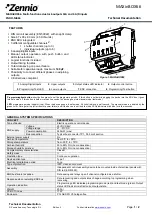
The seal on the threaded plugs/holders found on TLV products is formed by a flat metal
gasket. There are various installation orientations for the gaskets, such as horizontal, diagonal
and downward, and the gasket may be pinched in the thread recesses during assembly.
Instructions for Disassembly and Reassembly
①
Remove the plug/holder using a tool of the specified
size (distance across flats).
②
The gasket should not be reused. Be sure to
replace it with a new gasket.
③
Clean the gasket surfaces of the plug/holder and the
product body using a rag and/or cleaning agents, then check
to make sure the surfaces are not scratched or deformed.
④
Coat both the gasket surface of the plug/holder and
the threads of the plug/holder with anti-seize, then press
the gasket onto the center of the gasket surface of the
plug/holder, making sure the anti-seize affixes the gasket
tightly to the plug/holder. Check to make sure the
gasket is not caught in the recesses of the threads.
⑤
Hold the plug/holder upside down to make sure that
the anti-seize makes the gasket stick to the plug/holder
even when the plug/holder is held upside down.
⑥
Screw the plug/holder by hand into the product body while
making sure that the gasket remains tightly affixed to the center
of the gasket surface of the plug/holder. Make sure the entire gasket is making
contact with the gasket surface of the product body. It is important at this point
to make sure the gasket is not pinched in the thread recesses of the plug/holder.
⑦
Tighten the plug/holder to the proper torque.
⑧
Next, begin the supply of steam and check to make sure there is no leakage from the part
just tightened. If there is leakage, immediately close the inlet valve and, if there is a bypass
valve, take the necessary steps to release any residual pressure. After the surface of the
product cools to room temperature, repeat the procedure beginning from step
㈰
.
Gasket
Do not pinch gasket
in thread recesses
Coat with anti-seize
Gasket Surface
③
④
⑤
⑥
9. Instructions for Plug / Holder Disassembly and Reassembly
10. Troubleshooting
If the expected performance is unachievable after installation of the steam trap, read chapters 5
and 6 again and check the following points for appropriate corrective measures.
NOTE: When replacing parts with new, use the parts list on page 3 for reference, and replace with
parts from the Maintenance Kit and/or the Trap Unit.
No condensate is
discharged
(blocked), or
discharge is poor
Pressure exceeds maximum
operating pressure
Problem
Cause
Corrective Measures
Replace trap with appropriately rated model
or, if possible, reduce steam pressure
Clean the pipelines
Clean screen or channels
Replace the trap body with a new one
Replace with larger trap
Perform a bypass blowdown, or close the
trap inlet valve and allow the trap to cool
Correct the installation
Reinforce trap piping supports
Examine the piping for problems
Tighten to the proper torque (see page 3)
or replace gaskets
Pipelines upstream or down-
stream of the trap are clogged
In the connector body, the
screen or the inlet and outlet
channels are clogged
In the trap body, the inlet and
outlet channels are clogged
The trap capacity is too small
Steam locking has occured
Trap is installed above the
maximum allowable inclination
Severe vibration of trap
Water hammer has occurred
Screen holder gasket or
connector gaskets are loose or
damaged
Steam leakage or
blow-off
Steam leaks from
a place other than
the outlet
̶ 8 ̶






























